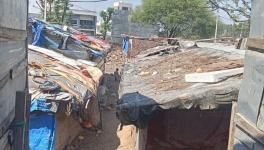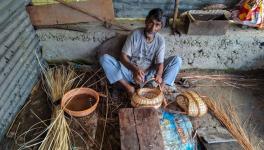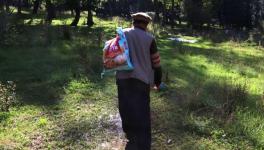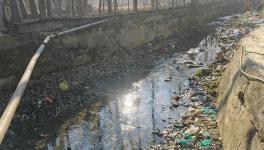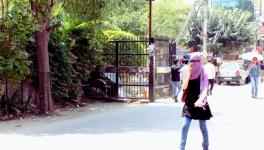North India Reels under Cold Wave, Temperature in Srinagar Drops to Lowest in 8 Years
Cold wave conditions persisted in north India this morning with fog reported in most parts. The northern states have been particularly affected with the temperature at Srinagar dropping to minus 7.8 degrees Celsius, the lowest there in eight years.
A cold wave gripped Delhi too on Wednesday as frosty winds from the snow-clad western Himalayas continued to sweep the plains and brought the minimum temperature down to 3.2 degrees Celsius, the IMD said.
“Dense” fog blanketed parts of the city, lowering visibility to 50 metres and affecting traffic movement.
Cold wave conditions prevailed at the Safdarjung Observatory, which provides representative data for the city. It recorded a minimum of 3.2 degrees Celsius, four notches below the normal, said Kuldeep Srivastava, the regional forecasting centre head of the India Meteorological Department (IMD).
The IMD declares a cold wave in the plains if the minimum temperature dips to four degrees Celsius. A severe cold wave is when the minimum is two degrees Celsius or less.
Cold and dry northerly/northwesterly winds from the western Himalayas have been barrelling through the plains, bringing down the minimum temperature in north India, Srivastava said.
Similar conditions will prevail in the city over the next two days, he said.
“Dense” fog lowered visibility to 50 metres at Palam and 200 metres at Safdarjung, the IMD said.
According to the IMD, “very dense” fog is when visibility is between zero and 50 metres. In the case of “dense” fog, the visibility is between 51 and 200 metres; “moderate” 201 and 500 metres, and “shallow” 501 and 1,000 metres.
Delhi had been registering above-normal minimum temperatures till Monday, as a cloud cover persisted over the city under the influence of successive Western Disturbances (Wds). However, the temperature started dropping with the commencement of cold northwesterly winds after the withdrawal of the latest WD.
The city's minimum had settled at 4.8 degrees Celsius on Tuesday, seven degrees Celsius on Monday, 7.8 degrees Celsius on Sunday, 10.8 degrees Celsius on Saturday, 9.6 degrees Celsius on Friday and 14.4 degrees Celsius on Thursday, the highest in January in four years, according to the IMD.
Intense cold wave conditions also prevailed in most parts of Punjab and Haryana this morning with Narnaul being the coldest place in both the states at 1.4 degrees Celsius.
Narnaul in Haryana recorded a low of three notches below the normal. Hisar was the other place where the mercury settled below the two degrees Celsius-mark. It registered a minimum temperature of 1.7 degrees Celsius, five notches below the normal.
Among other places in the state, Ambala, Karnal and Rohtak experienced cold conditions at 7.8, 6.5 and five degrees Celsius respectively, an IMD official said. Bhiwani and Sirsa reeled under cold conditions at 2.8 and 3.4 degrees Celsius respectively.
Chandigarh, the joint capital of both states, recorded a low of 5.7 degrees Celsius. The minimum temperatures at Pathankot, Adampur, Halwara, Bathinda, Faridkot and Gurdaspur settled at 9.2, 3.4, 3.6, 3.2, 4 and 8.2 degrees Celsius respectively.
A thick blanket of fog enveloped many places, including Bhiwani, Sirsa and Bathinda this morning.
The Kashmir Valley reeled under severe cold, with Srinagar city – the summer capital of Jammu and Kashmir – recording its lowest minimum temperature in eight years. Srinagar recorded a low of minus 7.8 degrees Celsius, which was the lowest temperature recorded in the city in eight years, a MET department official said.
He said the exact same minimum temperature was recorded in the city on January 14, 2012. The rest of the valley was also reeling under intense cold.
Pahalgam, which also serves as a base camp for the annual Amarnath Yatra in south Kashmir, recorded a low of minus 11.7 degrees Celsius – down from the previous night's minus 5.6 degrees Celsius.
The resort was the coldest recorded place in Jammu and Kashmir.
The minimum temperature in Gulmarg settled at minus ten degrees Celsius – up from minus 11.2 degrees Celsius the night earlier.
Kupwara in north Kashmir recorded a low of minus 5.6 degrees Celsius, while Kokernag in the south was at minus 9.9 degrees Celsius.
The sudden plunge in the minimum temperature resulted in freezing of water supply pipes. A thick layer of ice had frozen over many stagnant water bodies including the Dal Lake.
Kashmir is currently under the grip of 'Chillai-Kalan' – the 40-day harshest period of winter when a cold wave grips the region and the temperature drops considerably. The chances of snowfall are the most frequent and maximum during this period and most areas, especially in the higher reaches, receive heavy snowfall.
While 'Chillai-Kalan', which began on December 21, will end on January 31, the cold wave continues even after that in Kashmir with a 20-day 'Chillai-Khurd' (small cold) and a 10-day 'Chillai-Bachha' (baby cold).
With PTI Inputs
Get the latest reports & analysis with people's perspective on Protests, movements & deep analytical videos, discussions of the current affairs in your Telegram app. Subscribe to NewsClick's Telegram channel & get Real-Time updates on stories, as they get published on our website.










